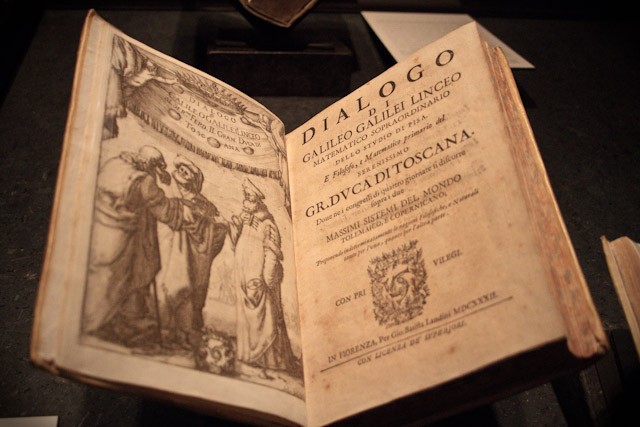
Galileo’s “Dialogue Concerning the Two Chief World Systems, Ptolemaic and Copernican” is on display, along with 36 other prohibited books, through Dec. 17 at the SMU Bridwell Library. (KALEN SCHOU/ The Daily Campus)
An unusual scene greets visitors to the exhibition hall at Bridwell Library this fall.
The overbearing silence coupled with the dim lights illuminating a larger-than-standard, damaged Bible commentary with some passages excised intrigues visitors.
The pages were deliberately removed by representatives of the early church in Europe in a bid to contain heretical or erroneous teachings.
Perkins School of Theology’s Bridwell Library is hosting an exhibition entitled “Heresy and Error.”
The exhibition focuses on the historical evidence offered by the intentional alteration and suppression of books by Christian censors in Europe during past centuries.
Of the 62 books and broadsides displayed, 37 were prohibited, enduring either the physical expurgation or the threat of destruction. Initially, censorship of the press was enforced locally.
However, with the spread of the Protestant Reformation, the Catholic Church required a more centralized and organized approach. It formed the Council of Trent (1545-1563), which printed rules for censorship and listed individual banned titles as well as authors whose writings had been condemned.
Catholic theologian Desiderius Erasmus and Protestant Reformer Martin Luther are among authors whose books were banned.
The officials also published lists of expurgations which identified specific passages to be deleted from every copy of a book that they deemed somewhat unacceptable.
One of the exhibits features an essay by Henric Van Cuyck, bishop of Roermond, in which he comments that the invention of printing by Johannes Gutenberg resulted in a world infected by “pernicious lies.”
Books could be censored for stating a position different from the Bible’s. Galileo Galilei’s book, “Dialogue Concerning the Two Chief World Systems, Ptolemaic and Copernica,” created controversy by placing the sun, not the Earth, at the center of the solar system.
This contradicted the biblical statement in Joshua 10:13 that God had made the sun stand still in the sky over the earth. Galileo’s book remained prohibited until 1824.
Both the writers and the printers assisted the censors in successfully implementing censorship rules.
“When the Index came out or a decree was issued, it would be the responsibility of the authors and printers to ensure that their works met the standards,” said Eric White, curator of Special Collections at the Bridwell Library.
The exhibition contributes to a fuller understanding of the role of post-publication censorship in religious controversies of the past.
It will run through Dec. 17 and has the same hours as the library.








